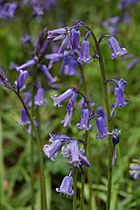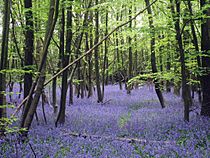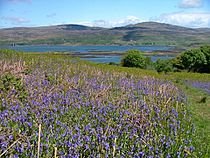Bluebell facts for kids
Quick facts for kids Bluebell |
|
|---|---|
 |
|
| Scientific classification | |
| Synonyms | |
|
The common bluebell (scientific name: Hyacinthoides non-scripta) is a beautiful bulb plant that lives for many years. You can find it growing naturally in western Europe, from Spain all the way to the British Isles. Many people also plant bluebells in their gardens.
Bluebells are famous for growing in ancient woodlands, where they can cover the ground like a purple-blue carpet. These areas are often called "bluebell woods". However, in some western areas, they can also grow in more open spaces. Bluebells are protected by law in the UK and some other places. There's also a similar plant, the Spanish bluebell (Hyacinthoides hispanica), which has been brought to the British Isles. These two types of bluebells can mix and create new kinds of bluebells called Hyacinthoides × massartiana.
Contents
About the Bluebell's Name
The common bluebell was first described by a famous scientist named Carl Linnaeus in 1753. He named it Hyacinthus non-scriptus. The word non-scriptus means "unlettered" or "unmarked". This name was chosen to tell it apart from the mythical hyacinth flower in Greek mythology.
In the Greek story, the god Apollo cried tears that marked the petals of a new flower with the letters "AIAI" (meaning "alas") after his friend, Prince Hyacinthus, died. The bluebell, however, doesn't have these "letters" on its petals, which is why it was called "unlettered."
Over time, scientists moved the bluebell into different plant groups. In 1934, it was finally placed in the group Hyacinthoides, which means "like a hyacinth." Even today, some people still call it by its older names, like "Scilla non-scripta."
Other Bluebell Species
The common bluebell is part of a small group of four closely related species. These include the Spanish bluebell (Hyacinthoides hispanica), Hyacinthoides paivae, and Hyacinthoides cedretorum. These plants are mostly found around the Iberian Peninsula (Spain and Portugal). H. paivae grows in a small part of north-western Iberia, while H. cedretorum is found in the mountains of North Africa.
What Does a Bluebell Look Like?
The common bluebell is a perennial plant that grows from a bulb buried in the ground. It usually has 3 to 6 long, thin leaves that grow from the base of the plant.
Its flowers grow on a stem that can be up to 50 centimeters (about 20 inches) tall. The stem usually droops at the top, and the flowers hang down on one side. Each flower is about 1.4 to 2 centimeters long. The six petals (called tepals) are a beautiful violet-blue color and curl strongly backwards at their tips. The flowers have a strong, sweet smell. Inside, the pollen is cream-colored. After flowering, the plant produces black seeds.
Bluebell bulbs have special roots that can pull them deeper into the soil, sometimes up to 10-12 centimeters (4-5 inches) deep. This helps them find more moisture, especially in dry times.
Common vs. Spanish Bluebells
It's important to know the difference between the common bluebell (H. non-scripta) and the Spanish bluebell (Hyacinthoides hispanica), which is an introduced species in the UK.
- Common Bluebell: Has dark, violet-blue flowers that hang on one side of the stem. The petals curl back a lot, and they have a strong, sweet smell. The pollen is cream-colored.
- Spanish Bluebell: Has paler flowers that grow all around the stem and stand more upright. Their petals don't curl back as much, and they have only a faint smell. The pollen is blue.
These two types of bluebells can easily cross-breed to create new plants called Hyacinthoides × massartiana. These hybrid plants often show features that are a mix of both parent species.
Where Bluebells Grow and How They Live
The common bluebell grows naturally in western Atlantic Europe. This includes countries like north-western Spain, Portugal, France, Belgium, the Netherlands, Great Britain, and Ireland. It has also spread and now grows wild in places like Germany, Italy, Romania, and even parts of North America and New Zealand.
Even though bluebells grow in many places, they are most common in the British Isles. It's thought that between 25% and 50% of all common bluebells in the world grow there! "bluebell woods," where the forest floor is covered in bluebells in spring, are a very common sight in the UK.
Bluebells are woodland plants. They grow and flower early in spring, before the trees above them grow their leaves and block out the sunlight. They prefer slightly acidic soils. Bluebells are often used as an indicator species. This means that if you find bluebells growing in a woodland, it's a good sign that it's an ancient woodland (a forest that has been around for a very long time).
Bluebell flowers are full of pollen and nectar, which makes them popular with insects. Bumblebees are their main pollinators, helping the plants make seeds.
Protecting Bluebells
The common bluebell is not protected by big international laws. However, it is a protected species in the United Kingdom under the Wildlife and Countryside Act 1981. This law makes it illegal for landowners to dig up wild bluebells from their land to sell them. It's also a crime to remove the bulbs of wild bluebells. In 1998, this law was made even stronger, making it illegal to trade (buy or sell) any wild common bluebell bulbs or seeds. Breaking this law can lead to big fines.
In France, bluebells are mostly found in the northern part of the country. While there isn't a national law protecting them, many local areas (called départements) have their own rules to protect bluebells. In Wallonia, Belgium, bluebells are also protected by law.
How People Use Bluebells
Bluebells are very popular as garden plants. People often plant them under trees or in flower beds because they look lovely and flower at the same time as other spring bulbs like hyacinths and tulips. Bluebells can spread quickly by growing new bulbs and seeds, so sometimes gardeners need to manage them so they don't take over.
Like other plants in their family, bluebells (especially their bulbs) are usually considered to be poisonous. However, bluebells also contain many natural chemicals that could be useful in medicine. Scientists have found at least 15 active compounds in bluebells that might help protect them from insects and animals. Some of these chemicals are similar to ones being studied for fighting serious diseases.
In the past, bluebell bulbs were used in folk medicine for different purposes, like helping with certain health issues or as a diuretic (to help the body get rid of water). The sticky sap from the plant could also be used as a type of adhesive (glue).
Many people in the United Kingdom love the bluebell. In 2004, a plant charity called Plantlife held a survey to find a favorite flower for each county in the UK. They actually had to stop people from choosing the bluebell because it was so popular in an earlier national poll! A picture of a bluebell is also used as the logo for the Botanical Society of Britain and Ireland.
In culture
"In and Out the Dusting Bluebells" (also known as "In and Out the Dusty Bluebells") is a well-known children's playground song and dance.






